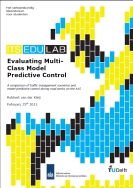Traffic control is the part of dynamic traffic management in which traffic management measures are controlled to optimize the capacity of networks. Since September 2011 traffic management scenarios are applied for the A15 highway, an important access road for the Port of Rotterdam Area. Traffic management scenarios is the most advanced traffic control method that is applied in practice today. The current state of art in traffic control research is Model Predictive Control (MPC), an adaptive method that calculates the optimal control signal and adjusts it to changing traffic states. In this study the MPC method is compared with the current implemented traffic management scenarios for the A15 highway eastbound. Since this highway has a high share of freight traffic from the port, traffic is divided into two user-classes and therefore a multi-class variant of MPC was also studied. The goal of this study was: to make a quantitative comparison based on economic costs between traffic management scenarios, single-class MPC and multi-class MPC.
Since the used traffic management scenario was created based on experience and MPC does not exist in practice yet, both methods were compared in a simulation study. BOS-HbR is a framework that fulfills the requirements and is therefore used for this study. BOS-HbR consists of an estimation and prediction component. In the estimation component the input data retrieved from loop detectors is converted to a traffic state which serves as input for the prediction component. The prediction component uses the multi-class model Fastlane to predict the traffic state and to predict the results of the control method which will be inserted here.
The simulation experiment was done for three cases: a heavy peak hour, a regular peak hour and a severe accident. For each case a validation was be done to check if the model predictions for Fastlane matched reality. Also for each of these cases the experiments were performed with 5 demand levels: 90%, 95%, 100%, 105% and 110% of the original expected demand. In this the robustness of the control methods was investigated. The results of the experiments were evaluated on the basis of the following performance indicators: total cost, average travel time per user class and robustness.
In the cases of the heavy peak hour applying single-class MPC showed double the improvement which traffic management scenarios achieved. In the regular peak hour this improvement was less and in the accident case the relative differences were minimal. In all cases single-class MPC performed better than traffic management scenarios, which already showed a good improvement over the situation where no traffic control is applied. Multi-class MPC had small improvements over single-class MPC, especially when looked at user-class specific travel times. All control cases show an equal sensitivity to demand fluctuations. Overall it can be concluded that Model Predictive Control shows approximately the same improvement over traffic management scenarios as the latter does over a situation where no traffic control is applied.
It is recommended to apply traffic management scenarios with route guidance on more locations in the Netherlands, because it showed that the results are good. It can also pave the way for a future implantation of Model Predictive Control. The traffic management scenarios currently used are designed based on experience. It will be interesting to see how traffic management scenarios that are designed and optimized with a traffic model will perform.
